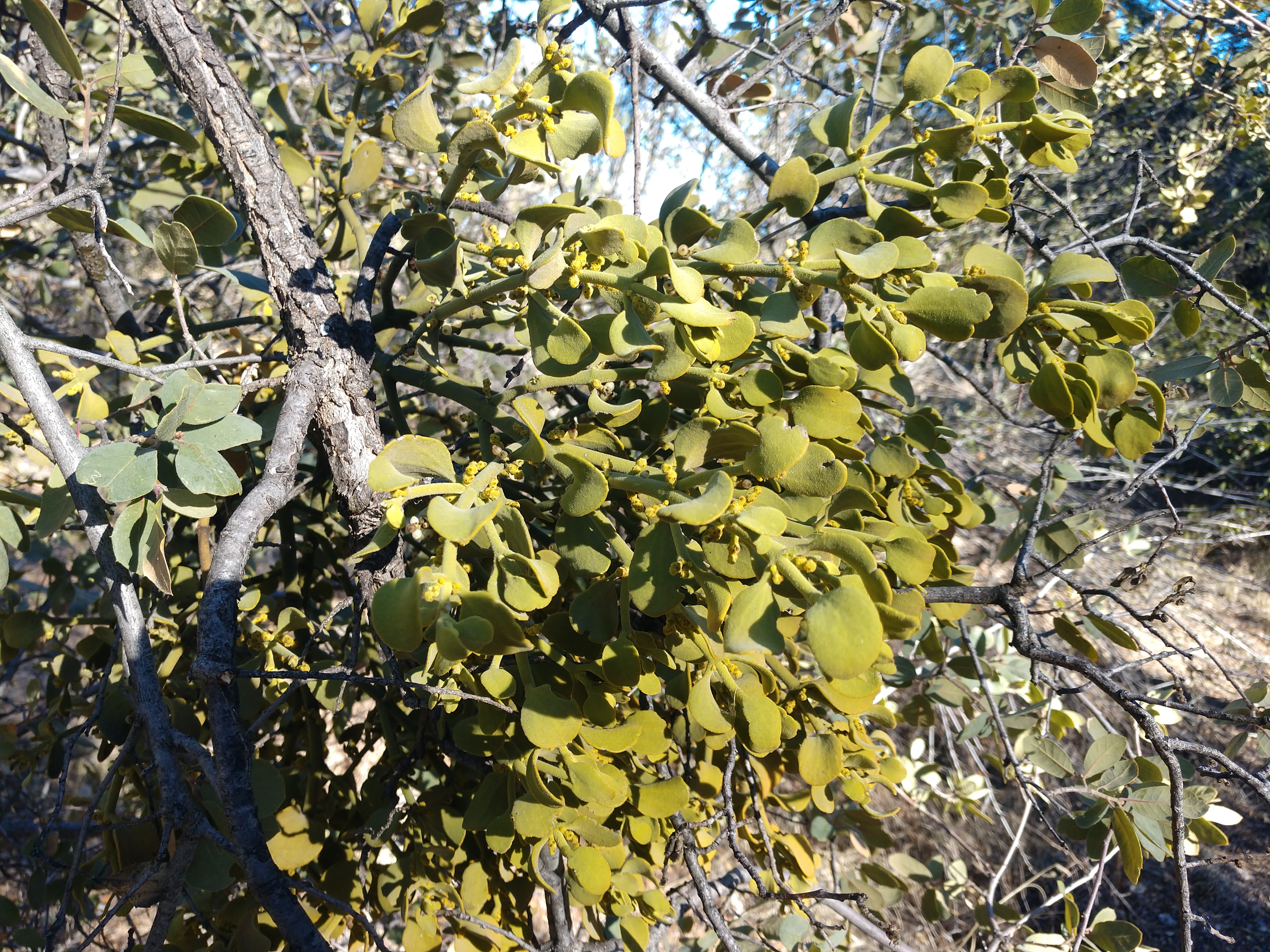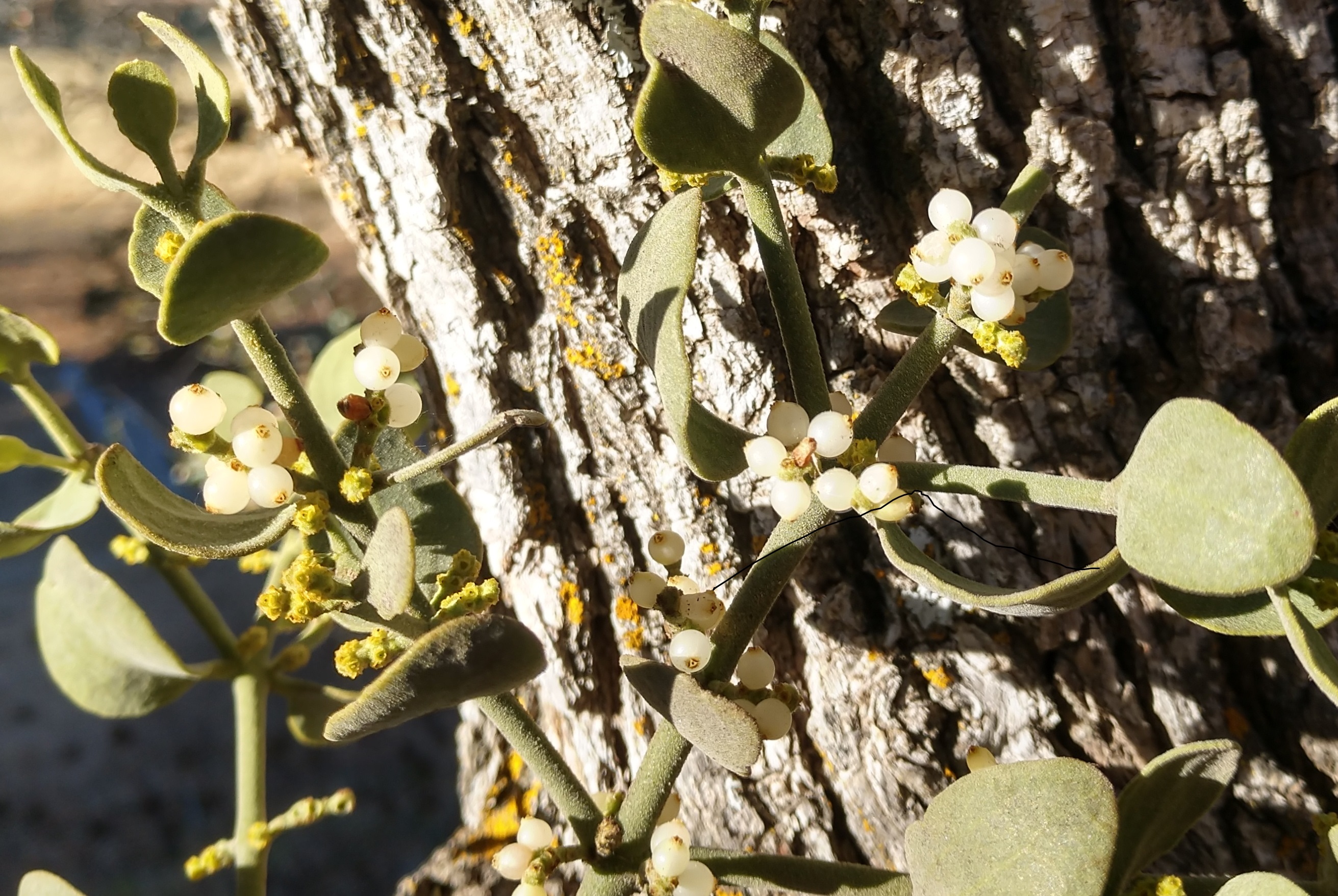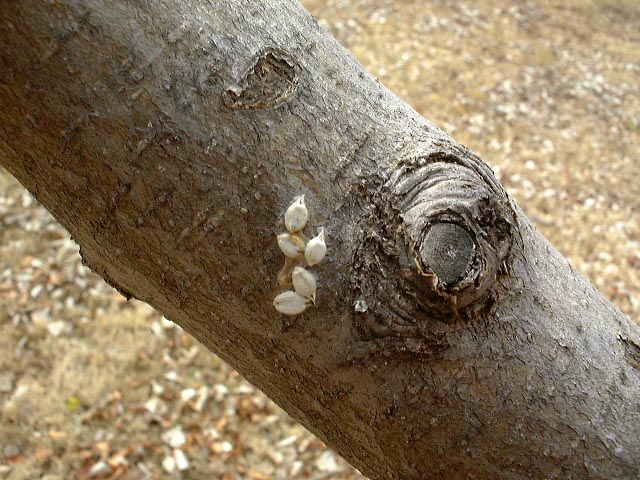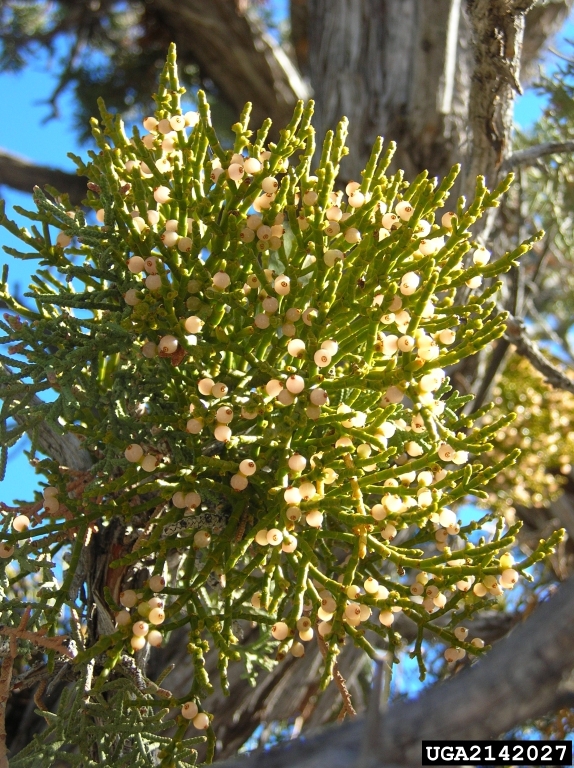 Mistletoe is a Native Plant - October 14, 2020 Jeff Schalau, Agent, Agriculture & Natural Resources University of Arizona Cooperative Extension, Yavapai County True mistletoes (also called leafy mistletoes) are green plants that utilize another plant, the host, to acquire water and mineral nutrients. Since true mistletoe is green and photosynthetic, it does produce its own food. While true mistletoes are considered parasites, they do not readily kill their host and have a few benefits for other species, primarily birds. North American true mistletoes are in the genus Phorodendron and are dioecious. In other words, female plants have flowers that are pollinated by male flowers on separate plants resulting in one-seeded berries on the female plants. Some bird species are reliant on mistletoe berries as a winter food source. The seeds are covered with a sticky material called “viscin”. Once eaten, they pass the seed through their gut yet some of the viscin still adheres to the seed causing it to stick to limbs where they roost. After germinating on a suitable host species, the mistletoe’s “roots” (called haustoria in the phloem and sinkers in the xylem) penetrate the host's bark and grow there. It can take up to two years before mistletoe shoots develop from this “root” system and small shoots emerge from the stem. True mistletoes are not to be confused with dwarf mistletoes. Dwarf mistletoes are not photosynthetic, found only on conifers, and much more damaging to their host plant. In Arizona, we have seven species of true mistletoe that are hosted by a variety of trees and shrubs over a range of elevations. In our area, you most commonly see true mistletoe on ash, oaks, cottonwood, willow, junipers, Arizona cypress, mesquite, and hackberry. While it can also be found on box elder, sycamore, or locust, I have not seen it as often on these species. Environmental conditions can affect the establishment and growth rate of true mistletoe. Vigor of true mistletoe plants is usually related to the vigor of the host, and mistletoe may decline in otherwise healthy trees during dry periods when host plants are water stressed. On the other hand, heavily infected trees are probably more susceptible to other stresses such as insects and disease. Seeds of most species require moisture for germination, so infections usually occur during periods of regular precipitation. Leafy mistletoe prevention is not practical because we cannot reliably influence bird behavior. Periodic recruitment of new young trees among older infested trees also allows some mistletoe to remain as part of the landscape. Since the berries of true mistletoes mature in winter, they are an important winter food source for some bird species. Often the areas of greatest mistletoe colonization follow natural drainages where suitable host trees grow and create excellent migratory bird habitat. Some people prune out mistletoe affected limbs or simply prune the mistletoe from the point where it emerges from the host. This does reduce competition between the mistletoe and host but may prevent the mistletoe from flowering and producing more seeds until it regrows. True mistletoe infections will sprout back if the mistletoe only is removed. When removing affected tree limbs can remove the infection if prune to a crotch at least one foot below the point of emergence. Always use proper pruning techniques. On newer infections, this can be very effective. However, on mature infections, you will need to evaluate how the tree might look after this pruning and you should never remove more than 30% of the canopy during one year. With severe infections where the owner is very concerned about an individual plant, I would recommend simply pruning out the mistletoe (not entire branches). It will resprout, but you will have decreased some of the stress on the host plant. The plant growth regulator ethephon may also be used as directed by the label to control mistletoe in dormant host trees in winter. As with hand removal, mistletoe will soon regrow at the same point, requiring retreatment. The net effect is similar to hand removal, but you won’t need to physically climb the tree. I have seen rare cases where true mistletoe has overcome the host, but usually the host lives for a long time. Supplemental irrigation may also help the host plant. You will have to decide for yourself, but mostly I tell people not to worry too much about true mistletoe and enjoy the bird watching. The on-line edition has photos and additional information (see URL below). You can follow the Backyard Gardener on Twitter – use the link on the BYG website. If you have other gardening questions, email the Master Gardener Help Desk in Prescott (prescottmg@gmail.com) or Camp Verde (verdevalleymg@gmail.com) and be sure to include your name, location, and phone number. Find past Backyard Gardener columns or provide feedback at the Backyard Gardener web site: https://cals.arizona.edu/yavapai/anr/hort/byg/. Images  True mistletoe (Phoradendron flavescens villosum) growing on Arizona white oak (Quercus arizonica) in Prescott, Arizona (Photo by Jeff Schalau, University of Arizona).
True mistletoe (Phoradendron flavescens villosum) growing on Arizona white oak (Quercus arizonica) in Prescott, Arizona (Photo by Jeff Schalau, University of Arizona). True mistletoe (Phoradendron flavescens villosum) berries growing on Arizona white oak (Quercus arizonica) in Prescott, Arizona (Photo by Jeff Schalau, University of Arizona).
True mistletoe (Phoradendron flavescens villosum) berries growing on Arizona white oak (Quercus arizonica) in Prescott, Arizona (Photo by Jeff Schalau, University of Arizona). True mistletoe (Phoradendron flavescens) seeds deposited on an apple tree branch in Cottonwood, Arizona (Photo by Jeff Schalau, University of Arizona).
True mistletoe (Phoradendron flavescens) seeds deposited on an apple tree branch in Cottonwood, Arizona (Photo by Jeff Schalau, University of Arizona). True mistletoe (Phoradendron juniperinum) in Utah juniper (Juniperus osteospermum), (Photo by: Brytten Steed, USDA Forest Service, Bugwood.org ).
True mistletoe (Phoradendron juniperinum) in Utah juniper (Juniperus osteospermum), (Photo by: Brytten Steed, USDA Forest Service, Bugwood.org ).Additional Resources True Mistletoes, University of Arizona Cooperative Extension extension.arizona.edu/sites/extension.arizona.edu/files/pubs/az1308.pdf True Mistletoes, New Mexico State University Cooperative Extension Service aces.nmsu.edu/ces/plantclinic/documents/mistletoes-_od-10__final.pdf Mistletoes, University of California IPM ipm.ucanr.edu/PMG/PESTNOTES/pn7437.html |